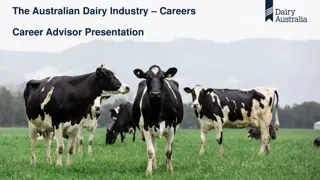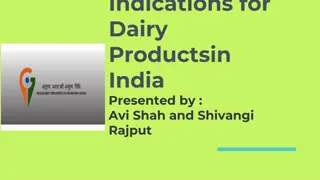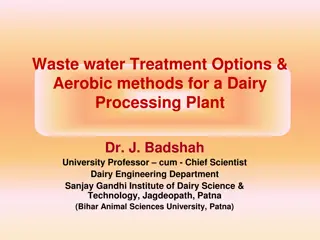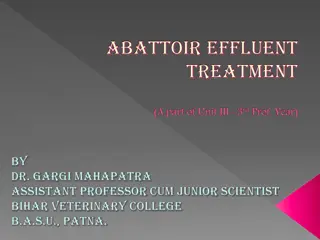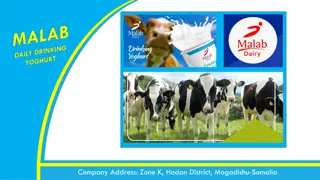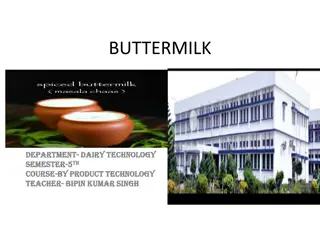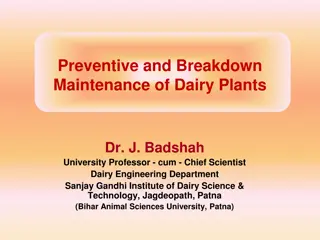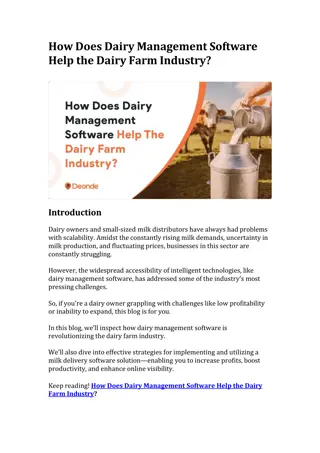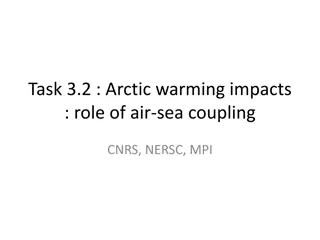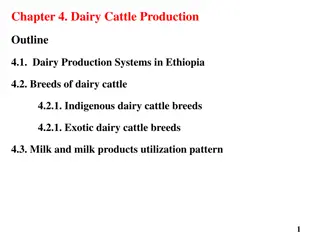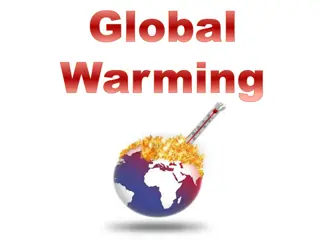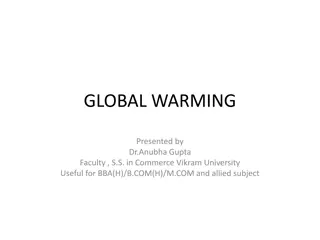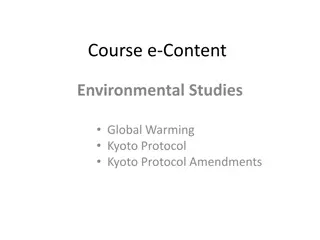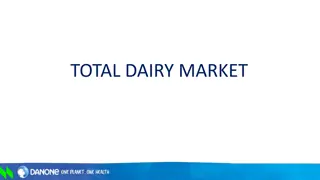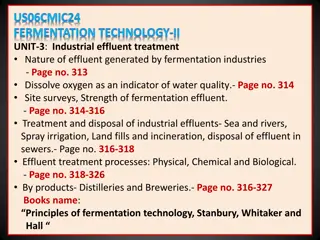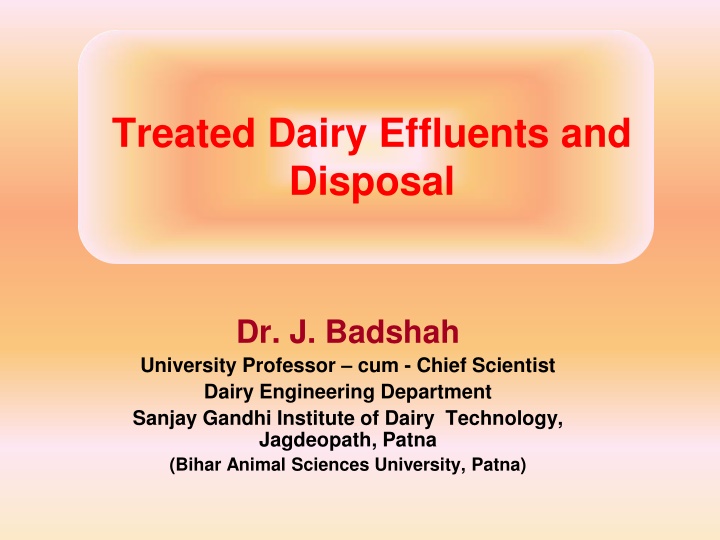
Treated Dairy Effluents and Global Warming Impact
Dairy farming and processing contribute significantly to greenhouse gas emissions, especially methane and nitrous oxide. Effluent discharge from dairy plants poses environmental challenges, requiring proper treatment and disposal methods to minimize impact. The industry needs to address GHG emissions and optimize energy usage to reduce carbon footprint effectively.
Download Presentation

Please find below an Image/Link to download the presentation.
The content on the website is provided AS IS for your information and personal use only. It may not be sold, licensed, or shared on other websites without obtaining consent from the author. If you encounter any issues during the download, it is possible that the publisher has removed the file from their server.
You are allowed to download the files provided on this website for personal or commercial use, subject to the condition that they are used lawfully. All files are the property of their respective owners.
The content on the website is provided AS IS for your information and personal use only. It may not be sold, licensed, or shared on other websites without obtaining consent from the author.
E N D
Presentation Transcript
Treated Dairy Effluents and Disposal Dr. J. Badshah University Professor cum - Chief Scientist Dairy Engineering Department Sanjay Gandhi Institute of Dairy Technology, Jagdeopath, Patna (Bihar Animal Sciences University, Patna)
Global warming from dairy farms and processing Man made activities have added significant quantities of green house gases (GHGs) to the atmosphere. The most important GHGs generated by the dairying ate methane (CH4), Nitrous oxide (N2O), carbon dioxide (CO2) and some refrigerant emission (CFCs and HFCs). The largest emissions of GHGs are due to dairy animals which accounts around 80 % of the GHG emissions of the total life cycle of milk.
Global warming from dairy farms and processing Main sources of GHGs emissions from dairying: Animals primarily CH4 emissions. Young animals below 3 months do not produce methane The manure storage CH4and N2O emissions Crop, pasture, direct emissions on the pasture and indirect emissions through leaching N2O emissions Feed productions- mainly N2O emissions Process energy consumption and fuel consumption for transport- CO2 Industry refrigeration for process, freezing and storage- CFCs and HFCs
Dairy Plants discharge Problems Need of permit to discharge waste waters directly to streams, bays, rivers, creeks and /or estuaries and land disposal from the state government control agency. Effluents from waste treatment systems must be sufficiently reduced in BOD and biological nutrients (e.g., P, NH3) as per the limits of Environmental regulatory agencies To reduce the volume of dairy wastewater to be treated and reduce treatment costs, careful attention must be given to minimizing losses of milk and milk products in the dairy plant. With good product conservation and selection of an effective waste treatment process, dairy plant operators should be able to operate profitably requirements. and meet environmental
Dairy Plants discharge Problems The combined effluent varies in its characteristics by way of its organic contact, BOD varying from 500 mg/l to 3500 mg/l. The dairy industry is not a major contributor to carbon foot- prints i.e. not contributing much GHGs. World summit held in Berlin in September, 2009 forced over the need to control the carbon foot print or GHGs emission. The dairy sector has to control the production of methane pollution resulting mainly from milk production systems. Secondly, the usage of energy intensive technologies have to be optimized by adopting various energy conservation programs and giving special policy thrust to decide the appropriate use of non-thermal technologies.
Dairy Plants discharge Problems and Solutions Similarly use of renewable energy resources such as biogas, solar energy, bio fuels energy etc. would place Indian dairy sector to a level field of international sanitary and hygiene standards. It will also derive the best benefits of the global carbon trading for India. As processes are becoming very costly to operate, and hence are becoming an economic burden to the dairy industry. the energy is becoming costlier, the aerobic
Alternative to Aerobic Treatments The first intermediate alternative is to go for anaerobic treatment. The dairy waste being highly bio-degradable, the anaerobic process should also be equally amendable to reduce the organic content for the wastes. Kadam and Saxena, 1996 mentioned the details of High rate activated sludge processes, Plastic media Bitowers and Upflow anaerobic Sludge blanket (USAB) process apart from anaerobic lagoons, lagoons and activated sludge process for effluent treatment systems in a dairy plant. oxidation ponds, aerated
Alternative to Aerobic Treatments The cheese whey has BOD in the range of 35000 to 60000 mg/l. Therefore, it is highly suited for anaerobic treatment because such streams with high BOD can yield biogas without requiring any energy. On the other hand, the biogas produced contains methane in the range of 65-80 % which can be used as the gaseous fuel replacing LPG or it may even be used simultaneously with diesel for running the diesel engine.
Guidelines for Carbon Credits and carbon Trading While finding solution to the Effluent disposal and Global warming problems, the concepts of carbon credit and trading come into picture as part of an international agreement, popularly known as Kyoto Protocol. Carbon credit is a generic term meaning that a value has been assigned to a reduction or offset of GHGs emissions. One carbon credit is equal to one ton of CO2, or in some markets, CO2equivalent gases. The goal is to allow market mechanisms to drive industrial and commercial processes in the direction of low emissions of GHGs.
Guidelines for Carbon Credits and carbon Trading Since GHGs mitigation projects generate credits, this approach can be used to finance carbon reduction schemes between trading partners and around the world. Carbon credits are certificates issued to countries that reduce their emissions of GHGs that leads to global warming. Animal waste methane recovery and utilization Installing an anaerobic digester & utilizing methane to produce energy Capture of biogas, Fuel switching from more carbon intensive fuels to less carbon intensive fuels, Renovation of older power plants, Upgrading instrumentation, controls and/or equipments, Changes in vehicles/Milk tankers and/or fuel type, for example, switch to electric cases or fuel cell vehicles (CNG/ Bio fuels)

